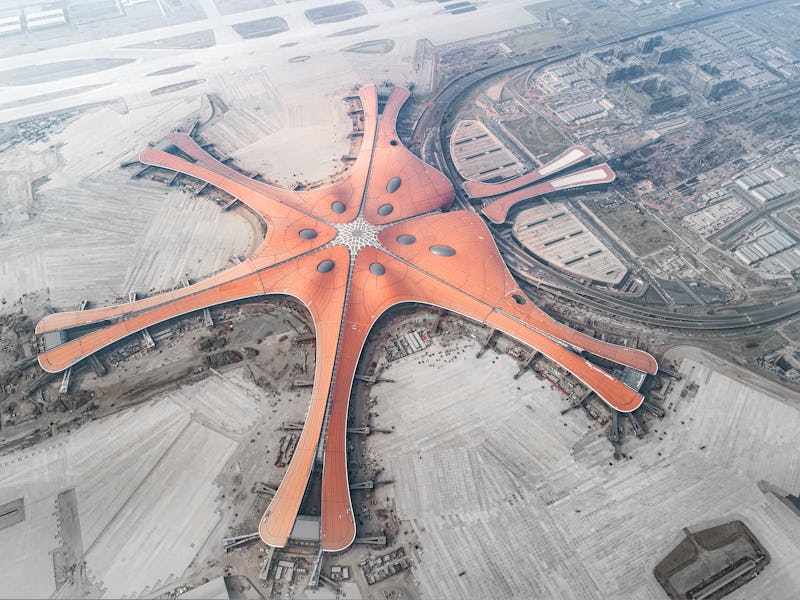The world's most jaw-dropping megaprojects fail for these reasons
Megaprojects like airports and transit lines are large and complex, but help is on the way.

Want to build the world's biggest airport, or the world's longest train tunnel? You'll want to take advice to avoid the pitfalls of previous planners.
Megaprojects like these, which tend to have costs exceeding $1 billion, can avoid failure by looking into five key areas. That's according to research from University College London published Thursday in Project Management Journal. The team looked at more than 6,000 academic summaries, filtering down to 86 papers that were fully analyzed to understand how megaprojects work.
These impressive feats of engineering have the ability to capture the imagination with their impressive ambition. Beijing's starfish-shaped Daxing International Airport, opened in September 2019, cost $11 billion and ranks as the world's largest single terminal. Switzerland's Gotthard base tunnel, opened in 2016, is the world's longest at 35 miles and cost around $12.3 billion.
But it doesn't always go to plan. High Speed 2, the United Kingdom's planned train line that would run at speeds of up to 250 mph, has risen from its proposed 2010 price of $39.1 billion to $138.1 billion. The original opening date for phase one has also slipped back from 2026 to as late as 2031. Similarly, California's proposed high-speed rail set to fully open by 2033 has jumped from its 2016 price of $64 billion to $80.3 billion.
Costs for HS2 have increased over the past decade.
Andrew Davies, professor of innovation management at the University of Sussex and one of the paper's authors, tells Inverse that the paper is an important step toward unpicking one of the great mysteries of construction.
"Despite some great research on optimism bias and inadequate front-end planning, we still don’t know why megaprojects fail to achieve their cost, time and quality objectives," Davies says. "This paper is one of the first studies to unpack what goes on inside the 'black box' of megaproject delivery, recognizing that successful performance depends on what happens during megaproject planning, execution and handover to operations."
The research could prove critical during an era declared by The Economist in 2008 as "the biggest investment boom in history." The paper points to 2014 research which found that global megaproject spending comes to around $6 trillion to $9 trillion every year, while 2013 research from McKinsey estimated around $57 trillion would be spent on these projects between then and 2030.
So what can planners do to avoid disaster? The paper sets out five areas of focus for future research:
- Designing the system architecture. More research needs to be done into roles and responsibilities on a project, and how different aspects may play a role.
- Bridging the gap with manufacturing. How can technologies like augmented reality and artificial intelligence work with other manufacturing techniques to make the process more streamlined?
- Building and leading collaborations. How can different methods of collaboration improve the way these projects come together?
- Engaging institutions and communities. How do institutional and cultural contexts influence a project?
- Decomposing and integrating the supply chain. These complex structures require more research.
The paper identifies 18 causes and 54 cures aimed at developing a solution to the issues. Although more work needs to be done to identify how teams can move forward, the research has been welcomed as a step forward.
"The success of megaprojects is vital to economies across the world," Peter Hansford, honorary professor of UCL and former chief construction adviser for the UK Government, said in a statement. "But all too frequently, they fail to satisfy their objectives in material respects - sometimes with very serious social and economic consequences. It is therefore of urgent importance to understand why megaprojects underperform and what needs to be done to prevent them doing so."
Hopefully next time someone has a bridge they want to sell you, they'll be able to deliver it to expectations.
Read the abstract below:
This systematic literature review explores the megaproject management literature and contributes by improving our under- standing of the causes and cures of poor megaproject performance. The review analyzes 6,007 titles and abstracts and 86 full papers, identifying a total of 18 causes and 54 cures to address poor megaproject performance. We suggest five avenues for future research that should consider examining megaprojects as large-scale, inter-organizational production systems: (1) design- ing the system architecture; (2) bridging the gap with manufacturing; (3) building and leading collaborations; (4) engaging institu- tions and communities; and (5) decomposing and integrating the supply chain.